I was leaving the local butcher shop the other week when a bigger carnivore blocked my path: The driver of a Ford pickup was struggling to park his rig. It was the most-super of Super Duties — a crew cab long-box dually — so it took him a couple of minutes and several cuts of the wheel to ease the beast into a prime spot near the store entrance. He was holding up a lot of traffic.
That's a tight parking lot, with spaces 8-8½ feet wide. And the width of that dually at the hips? Also 8 feet. What was he thinking? Other than, “I’d rather do this than go find an easy spot on the back row and walk 50 yards.” Maybe he had a bum knee. Doesn't make his truck any smaller.
Granted, this was over the holidays, when parking lots get a little nuts. But why do drivers of big pickups or jumbo SUVs try to park among the normies?
We’ve all been in this situation: You return to your vehicle to discover somebody parked too close. You have to crawl in through the back hatch, or enter on the passenger side and clamber over the center console. Sometimes this is simply because of a bad parking job. Sometimes, a vehicle has been jammed into a space where it honestly doesn’t fit.
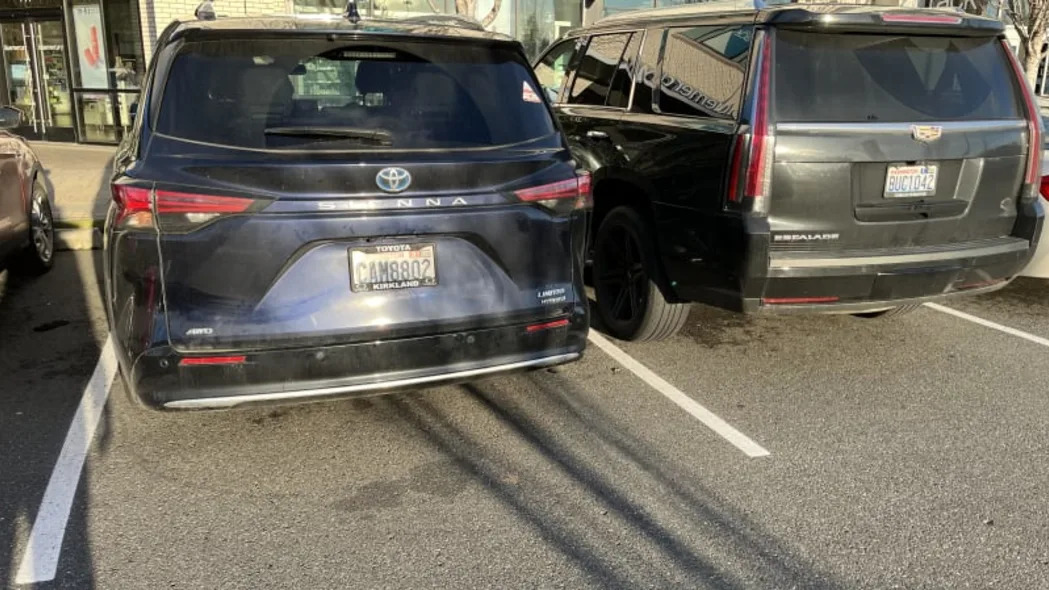
A Sienna and Escalade in 8½-foot spaces, about 18 inches apart. The minivan was there first; somehow the slender driver managed to slip out of the Escalade. But hey, she scored a spot close-in.
A typical parking space is 8 feet, or 96 inches. Sometimes 8½-9 feet. Perhaps not surprisingly, lots are not always striped very precisely. I've measured spots ranging from 7 to 10 feet wide in the same lot. Also, there might be regional differences — perhaps they're bigger in Texas. A sedan or small to medium SUV fits a typical spot just fine: A Honda Accord is 73 inches wide, a Toyota Corolla 70; CR-V and RAV4 are 73ish. If you’re dead-centered in an 8-foot space, that leaves about a foot of that space on each side. Assuming the same thing of the car parked next to you, you have 2 feet of room to exit. That's comfortable.
Those are the cars these spaces were made for.
But the trend toward bigger vehicles has made things uncomfortable. Full-size pickups are notoriously bigger than they were just a few years ago. They're around 80 inches, with Silverado at over 81. That's body width; some truck mirrors can span a full parking spot. Extreme examples are duallies, Cybertruck "Cyberbeast" at almost 87, Raptor at 87 inches, GMC Hummer at 87, Ram TRX at 88. Let's hope you rarely encounter those at a mall.
A Ford Maverick at under 73 inches, though, provides a welcome bit of cognitive dissonance: It’s a pickup, yet look at all this room! You can park it anywhere.
Midsize to large SUVs are 78-80 inches. Suburban/Tahoe/Escalade, 81. Jeep Grand Wagoneer is 83.6”, surpassing most pickups. Minivans are 80ish, but God bless sliding doors.
You’d think 6-8-10 inches wider than a sedan shouldn’t make much difference, but for, ahem ... some of us ... who are trying to squeeze out a door, it matters.
There’s a Golden Rule aspect to all this. Crowding your big truck into a too-small spot feels like the controversy over whether to recline your seat on a packed plane.
One of my personal vehicles is a Volvo XC90, 79 inches. Let’s do that math: 96 minus 79 leaves 8.5 inches on each side. If next to a Civic or something, that’s fine, your door can open into their space. But alongside another big vehicle — and odds are, it will be — you’ve got 17 inches between. As a frame of reference, the first detent on the Volvo’s front door is 21 inches; the rear door’s first detent is 23 inches. So, 17 is a tight squeeze. In the XC90, I pass up a lot of spots.
None of this is a knock on big vehicles; people have their reasons for buying them. But they park in suboptimal spaces because that’s what’s available. A study last year concluded that we bigger Americans in bigger cars need bigger spaces. In an ideal world, rather than maximizing the number of spots, retailers and those who design parking lots and garages would address the big-vehicle trend. Yeah, right.
This Washington state government guideline suggests 9 feet wide for diagonal spots, 10 feet for perpendicular. Nobody here seems to be doing that. I've stepped off an isolated 10-footer or two where the painters simply didn't divide the spaces evenly. But it’s more common to see 7.5 than 10. Which brings up those spots labeled “compact.” Drivers desperate for a space will ignore that guidance and jam anything in there. A medical building garage near here has a row of 14 spots marked "compact" on each of four floors — they're just 7 feet wide. That's not a mistake, that's a concerted effort to cram cars in and maximize parking fees. The same goes for pay lots in downtown city cores.
However, this next thing is great: Occasionally you'll see thoughtfully painted buffer zones between spots. Praise be to any merchant who does that, let’s give those businesses our patronage and dollars. In this Safeway lot, the spaces are 8½ to 9 feet, with a foot of DMZ between them. It's such a comfortable space that some cars were parked lazily crooked, but it wasn't a problem. Love the DMZ:
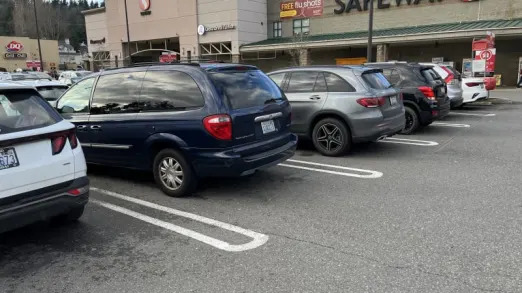
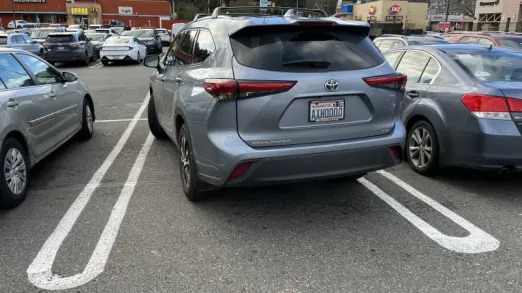
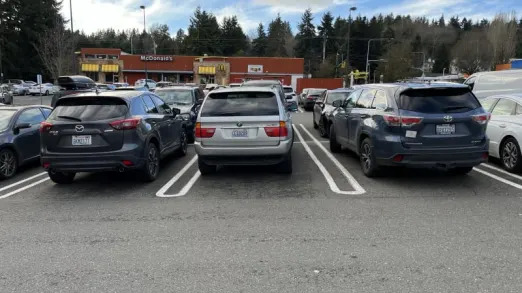

There’s a Golden Rule aspect to all this. Crowding your big truck into a small spot feels like the controversy over whether to recline your seat on a packed plane. Some airline passengers think it’s their right; those on the other end of that situation are furious that they can no longer use their laptop and are forced to stare at your bald spot for the rest of the flight. Now, if you ask and receive permission before leaning back, fine. Otherwise, it's not very nice. And while you can wedge a big vehicle into a spot that was marked off decades ago for passenger cars, should you?
Sometimes there's no choice. The blame is on lots and garages. They might be following some zoning guidance on number of stalls, but you can be sure they want to maximize customers. Meanwhile, the urban upfitting movement would like to limit parking. But until/unless stalls are supersized to match our supersized vehicles, discretion is valor and I prefer a nice, isolated spot way out on the fringe. Take up a position on an outer circle of retail hell. You’re protecting your own paint. And it’s usually quicker to park out there than to circle endlessly for a spot close-in.
A staple of news reporting is 100th birthdays. In one of those stories a few years ago, the lady celebrating her centennial said she had two secrets to her long life. First, she still worked part-time at some little job, a hardware store IIRC, which gave her a reason to be with people. Her other longevity tip: She parked (yes, apparently she still drove!) at the far edge of the lot. The walk kept her young, she said.
We haven't always been getting along as a polite society recently. Doing small kindnesses for one another can help. So park centered and true, and scatter to the fringes. The walk would do us all good.
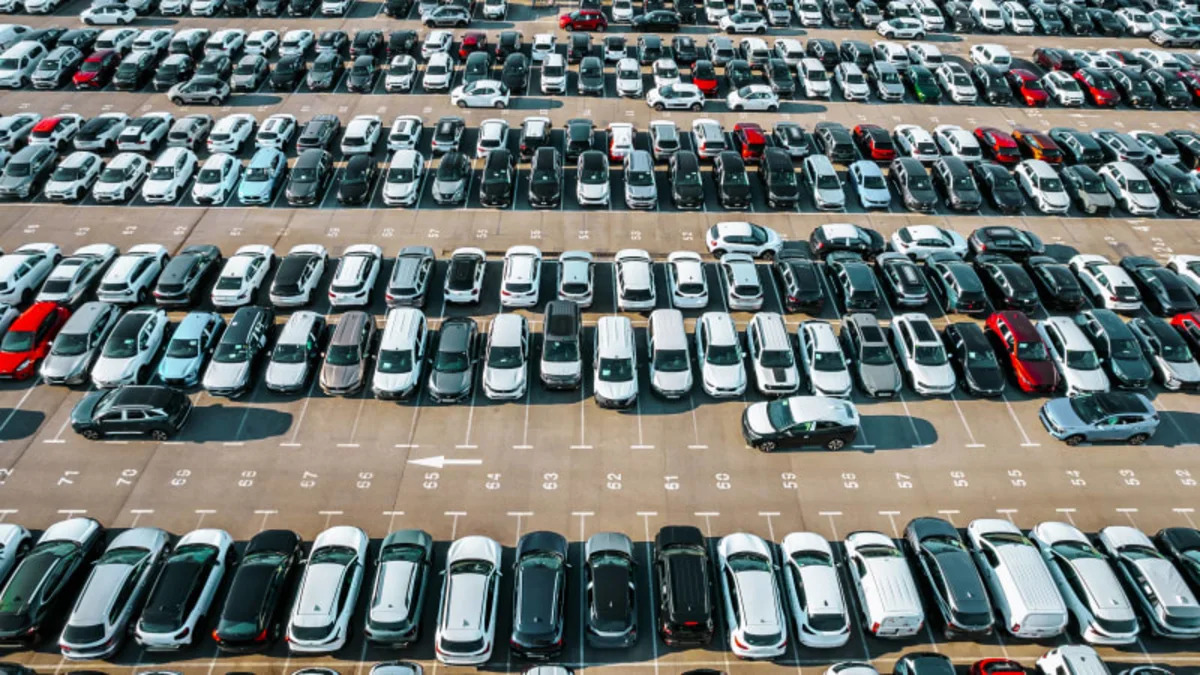

Sign in to post
Please sign in to leave a comment.
Continue